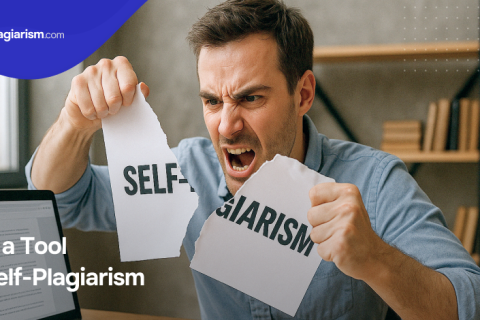Teaching Students about Plagiarism
25 Apr 2022

To catch in the act and punish! Isn’t it the only desire of a teacher who is suspicious of plagiarism in the students’ papers? For sure, it does irritate when one gets a copy-pasted article from a journal instead of an independent research. Plagiarism is an acute pain and it is complicated for the teachers to figure out how they can eliminate it effectively. A warning? A threat of expulsion? What is the right way to combat this plague of present-day academic writing? Hold on! Are you absolutely confident that plagiarizers know exactly that they are committing a crime? Isn’t it better to ask another question: ‘Why do students plagiarize?’ and ‘How much plagiarism is caused by ignorance, not evil intentions?’ The answers can definitely lead to a conclusion about the value of teaching students how to write without plagiarism before punishing for neglecting the standards.
Why do Students Plagiarize? Ways to Prevent That
Progressing in studies, the students are expected to understand how to produce original texts with no signs of plagiarism and have some in-born skills of dealing with complicated assignments. Unfortunately, they often do not have any set of skills needed for proper writing and they weave previous research in their papers by stealing ideas. Alas! Even simple plagiarism detection software easily traces this offence and the students get punished. How can a school prevent this?
- Teaching the students identify plagiarism. A common lecture or several sessions would be helpful if they introduce the students to the most typical examples of plagiarized assignments and consequences of such attitude to writing tasks.
- Giving the students a chance to try citing references correctly. Practice is of great value when a teacher can guide you in accurate citing the sources or paraphrasing ideas. The teacher’s immediate feedback with all the explanations is generally enough to show how plagiarism can spoil academic reputation and how easily one can avoid this problem.
What Is Needed is Getting Tools for Improvement
Although it may sound excessively easy, the most important thing to focus on in teaching students to change their attitude to plagiarism is the basics of formatting. It is sad, but there are not many students who pay sufficient attention to the issues of primary concern.
- Is it necessary to cite here?
This is a fundamental question asked by every other student although the answer seems to be in the air. It is the responsibility of a teacher to help every student distinguish between common facts and important details to be properly referenced. The line between them is frequently so blurry that plagiarism becomes a direct consequence of misunderstanding. There are papers with every sentence cited and others which have one or two random citations. What can a teacher to do assist? For sure, theoretical guidance is important, but practical examples have even more value. Explaining what common knowledge is when a student is just at the beginning of the course can save them from making a lot of stupid mistakes.
- How should I cite?
The students always search for help with paraphrasing and composing in-text citations in their assignments. They rearrange phrases, change passive structures into active and vice versa, take synonyms to replace some words and then sincerely believe that the idea now belongs to them, not to the original author. If a teacher devotes at least an hour to exercises that imply paraphrasing in the context of citing ideas and then makes sure that this practice is repeated from time to time, the students will feel confident in this activity and perceive it as a regular thing to do. It will be one of the important skills they will get at school and it will serve them throughout their lives.
- Where can I get help to cite properly?
The students typically remember the basics of citation styles, but they may forget about some minor details which are also important in proper referencing. There are some technologies and online tools which help the students cope with citing in Chicago, APA, MLA, Turabian, and other styles as the students just request for guidance in a specific paper. For sure, it is essential to double check with the standards of a certain style whether the full citation is done properly, but then one may make use of this handy tool. It is not reasonable to try and remember about every comma or full stop in a reference, so it makes sense not to teach the students to rely only on their memory, but to use the advances of technology. Some word processors have automatic in-built technologies which help the users with following all rules of citing.
Manual use of citations requires too much effort and the students are more likely to have original papers without plagiarism if the students are encouraged to use the tools for correct citing.
What Are the Possible Consequences of Plagiarism?
From an early age, the students should be told about citing and consequences of plagiarism. Providing them with useful and practical information, the teachers focus on forming the basic skills and encouraging more efficient research. If a student is equipped with the knowledge needed to avoid all issues related to plagiarism, it is much easier to write great papers and get good grades. Unfortunately, not every student will know perfectly well how to cite the used materials, but at least many will get a good chance to fill out the gaps in knowledge and prevent terrible consequences of plagiarizing.
What may happen when students plagiarize?
- they get grade penalties;
- they fail in a course;
- they cannot show how creative they are;
- they provide poor-quality ideas which do not have significant value;
- they cannot excite the readers’ interest;
- they may get their careers ruined;
- not only personal, but also professional reputation may be damaged.
Education in terms of plagiarism cannot cover all the aspects, but it is still enough to build the foundation for understanding all the standards of academic writing. Proper quotations and close attention to detail make it possible to avoid plagiarism. Diligent students after training come up with unique content and prevent adverse effects of plagiarism in writing.






